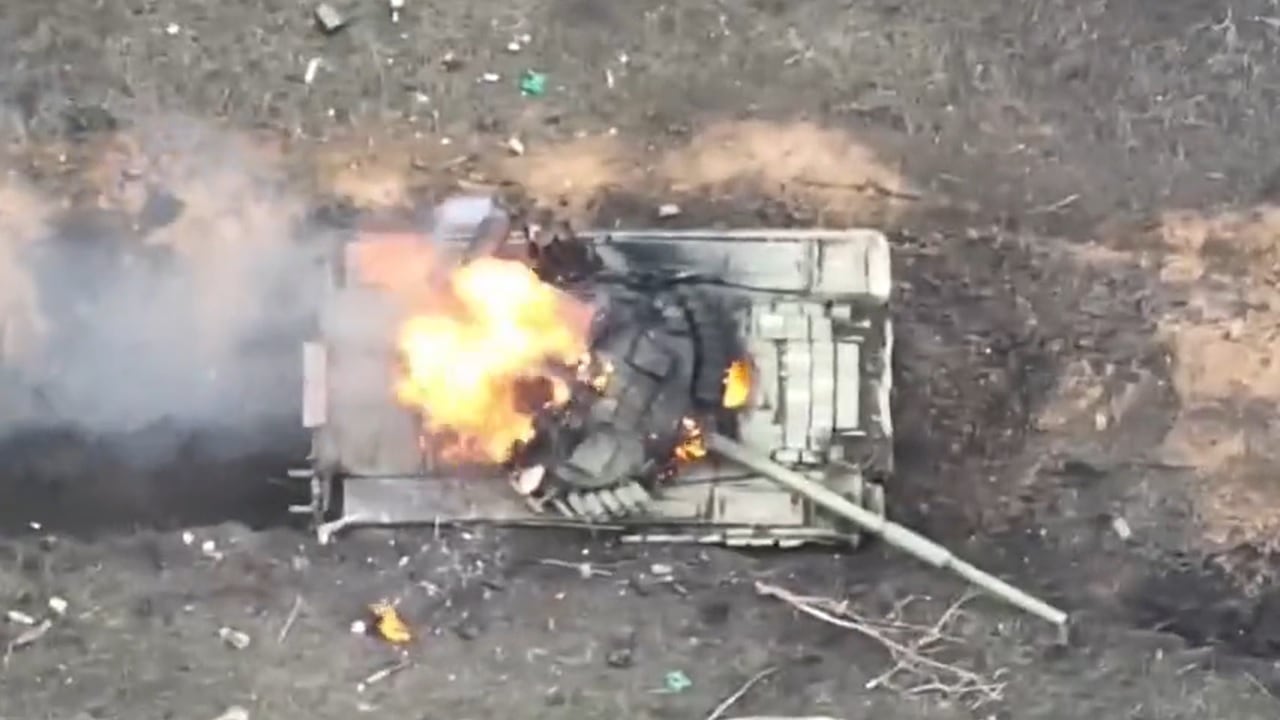Over the past seventeen months, there has been no shortage of Russian military vehicles that were destroyed by low-cost Ukrainian drones, or unmanned aerial vehicles (UAVs).
This week, open-source intelligence analysts noted the costs of the drones that have been employed in a recent strike – and highlighted the cost-effectiveness.
The ability for these platforms to target, then disable, and even destroy an enemy armored personnel carrier (APC) or main battle tank (MBT) has proven to be a game changer.
In a video shared on social media earlier this week, a Ukrainian unit showed how six first-person view (FPV) drones successfully found and destroyed three Russian vehicles including a BMP-1, BMP-2, and BTR-82A.
The reported cost of the drones was $2,100 – far less than the cost of man-portable anti-tank guide-missile platforms such as the U.S.-made FGM-148 Javelin or the British/Swedish NLAW platforms, and certainly significantly less the cost of any of those vehicles.
Striking From a Distance
In addition to being far less expensive than the anti-tank rocket launchers, drones have also allowed Ukrainian warfighters to maintain an even safer distance. Yet, the capabilities of drones were actually unknown as Russian forces massed on Ukraine’s borders in early 2022 – and in fact, little consideration was given to them by military analysts.
Instead, it was expected that Ukrainians would have to rely on low-tech anti-tank weapons such as gasoline bombs thrown at enemy tanks. Such improvised weapons are still being employed, but instead of the “Molotov cocktails” being thrown, drones are dropping them – as well as other ordnance – with pinpoint accuracy onto the enemy vehicles.
However, Ukraine had clearly seen drones as being crucial to countering Russia’s superior numbers of tanks and other vehicles.
“They are the super weapons here,” Anton Gerashchencko, an advisor to Ukraine’s minister of internal affairs, told Newsweek earlier this year. “We will be faster and with fewer losses if we have tens of thousands, hundreds of thousands of reconnaissance and combat drones.”
The Drone Programs
Currently, dozens of Ukrainian companies are now developing drones to help Kyiv drive out the Russian invader. Many of the companies sprung up after Russia illegally annexed Crimea and occupied parts of the Donbas in 2014, but eight years later another wave of startups were formed to develop drones.
The first drones were merely used to help Ukrainian artillery better target Russian positions and vehicles – and even in that role, the low-cost aerial platforms proved invaluable. Then the Ukrainians took it further and improvised ways for the drones to drop small but still deadly ordnance directly onto a vehicle.
CNN reported last month that the newly formed Ministry of Digital Transformation even held a competition with FPV drone makers to find the next platform that could be employed on the frontlines.
“Every few weeks, we conduct various studies, see what is happening in this direction, look for new drone developers, study the results,” Deputy Prime Minister and Minister for Digital Transformation Mykhailo Fedorov told CNN. “It is very important for us to find companies that can scale, to look at new usage formats, because this is a technological war.”
Attack of the Drone Warriors
It isn’t just developing new drones that could prove vital to the Ukrainian efforts. Kyiv will still need operators who are able to fly drones against the Russians. While still “safe” on the ground, the operators will need to be close to the front.
With Ukrainian government support, private groups have trained 10,000 drone pilots in the past year, and now plan to train 10,000 more in the next six months, NPR reported.
Unlike manned aircraft, drones are easier to fly – and “pilots” can be trained on the basics in just a day, while it can take several days of intense training to learn to operate a drone in difficult conditions, as well as how the radio frequencies work and even how the Russians are countering the drones.
The biggest advantage of drones is still the low cost.
Though Kyiv has pressed for aircraft such as the F-16 Fighting Falcon, it should be noted that a drone that can drop a bomb with such accuracy on a tank is vastly cheaper. For the cost of a single F-35 Lightning II, which Ukraine won’t possibly receive, it could get 55,000 small drones.
Even a fraction of the number of drones could destroy a lot of expensive Russian APCs.
17.07.23 our company using 6 FPV drones found and destroyed Russian BMP-1, BMP-2 and BTR-82A.
We have spent 2100$. Can anyone count how much Russian forces have lost?
Here is a video of destruction of a immobile BMP-2. pic.twitter.com/59YJXWLXXJ
— Kriegsforscher (@OSINTua) July 19, 2023
Author Experience and Expertise
A Senior Editor for 19FortyFive, Peter Suciu is a Michigan-based writer. He has contributed to more than four dozen magazines, newspapers, and websites with over 3,200 published pieces over a twenty-year career in journalism. He regularly writes about military hardware, firearms history, cybersecurity, politics, and international affairs. Peter is also a Contributing Writer for Forbes and Clearance Jobs. You can follow him on Twitter: @PeterSuciu.

